Libya: Difference between revisions
Tawkerbot2 (talk | contribs) m BOT - rv 69.210.96.217 (talk) to last version by Elb2000 |
citation didn't support text, "infamous" is POV |
||
| Line 64: | Line 64: | ||
The name "Libya" is derived from the [[Ancient Egyptian language|Egyptian]] term "Lebu", referring to [[Berber]] peoples living west of the [[Nile]], and was adopted into [[Greek language|Greek]] as "Libya". In [[ancient Greece]], the term had a broader meaning, encompassing all of [[North Africa]] west of Egypt, and sometimes referring to the entire continent of [[Africa]]. |
The name "Libya" is derived from the [[Ancient Egyptian language|Egyptian]] term "Lebu", referring to [[Berber]] peoples living west of the [[Nile]], and was adopted into [[Greek language|Greek]] as "Libya". In [[ancient Greece]], the term had a broader meaning, encompassing all of [[North Africa]] west of Egypt, and sometimes referring to the entire continent of [[Africa]]. |
||
With one of the largest proven oil reserves in the world,<ref>Annual Statistical Bulletin, (2004), [http://www.opec.org/library/Annual%20Statistical%20Bulletin/interactive/2004/FileZ/XL/T33.HTM <u>"World proven crude oil reserves by country, 1980–2004"<u>], ''O.P.E.C.'', Accessed July 20 2006</ref> Libya has one of the largest per capita GDPs in Africa.<!--I'm unsure of the difference between per capita economy and per capita gross domestic product; is it worth making this unclear distinction?--><ref>World Economic Outlook Database, (April, 2006), [http://www.imf.org/external/pubs/ft/weo/2006/01/data/dbcoutm.cfm?SD=2005&ED=2005&R1=1&R2=1&CS=3&SS=2&OS=C&DD=0&OUT=1&C=512-941-914-446-612-666-614-672-311-946-213-137-911-962-193-674-122-676-912-548-313-556-419-678-513-181-316-682-913-684-124-273-339-921-638-948-514-686-218-688-963-518-616-728-223-558-516-138-918-353-748-196-618-278-522-692-622-694-156-142-624-449-626-564-628-283-228-853-924-288-233-293-632-566-636-964-634-182-238-453-662-968-960-922-423-714-935-862-128-716-611-456-321-722-243-965-248-718-469-724-253-576-642-936-643-961-939-813-644-199-819-184-172-524-132-361-646-362-648-364-915-732-134-366-652-734-174-144-328-146-258-463-656-528-654-923-336-738-263-578-268-537-532-742-944-866-176-369-534-744-536-186-429-925-178-746-436-926-136-466-343-112-158-111-439-298-916-927-664-846-826-299-542-582-443-474-917-754-544-698&S=NGDPDPC&CMP=0&x=14&y=10 <u>"Report for Selected Countries and Subjects"<u>], ''International Monetary Fund'', Accessed July 15 2006</ref> Libya is led by revolutionary [[Mu’ammar Abu Minyar al-Qadhafi|Col. Muammar al-Gaddafi]], |
With one of the largest proven oil reserves in the world,<ref>Annual Statistical Bulletin, (2004), [http://www.opec.org/library/Annual%20Statistical%20Bulletin/interactive/2004/FileZ/XL/T33.HTM <u>"World proven crude oil reserves by country, 1980–2004"<u>], ''O.P.E.C.'', Accessed July 20 2006</ref> Libya has one of the largest per capita GDPs in Africa.<!--I'm unsure of the difference between per capita economy and per capita gross domestic product; is it worth making this unclear distinction?--><ref>World Economic Outlook Database, (April, 2006), [http://www.imf.org/external/pubs/ft/weo/2006/01/data/dbcoutm.cfm?SD=2005&ED=2005&R1=1&R2=1&CS=3&SS=2&OS=C&DD=0&OUT=1&C=512-941-914-446-612-666-614-672-311-946-213-137-911-962-193-674-122-676-912-548-313-556-419-678-513-181-316-682-913-684-124-273-339-921-638-948-514-686-218-688-963-518-616-728-223-558-516-138-918-353-748-196-618-278-522-692-622-694-156-142-624-449-626-564-628-283-228-853-924-288-233-293-632-566-636-964-634-182-238-453-662-968-960-922-423-714-935-862-128-716-611-456-321-722-243-965-248-718-469-724-253-576-642-936-643-961-939-813-644-199-819-184-172-524-132-361-646-362-648-364-915-732-134-366-652-734-174-144-328-146-258-463-656-528-654-923-336-738-263-578-268-537-532-742-944-866-176-369-534-744-536-186-429-925-178-746-436-926-136-466-343-112-158-111-439-298-916-927-664-846-826-299-542-582-443-474-917-754-544-698&S=NGDPDPC&CMP=0&x=14&y=10 <u>"Report for Selected Countries and Subjects"<u>], ''International Monetary Fund'', Accessed July 15 2006</ref> Libya is led by revolutionary [[Mu’ammar Abu Minyar al-Qadhafi|Col. Muammar al-Gaddafi]], whose foreign policy and involvement with [[terrorist group]]s have often brought him into conflict with the [[Western world|West]]. |
||
== History == |
== History == |
||
Revision as of 00:33, 8 August 2006
Great Socialist People's Libyan Arab Jamahiriya الجماهيرية العربية الليبية الشعبية الإشتراكية العظمى Al-Jamāhīriyyah al-Arabiyyah al-Lībiyyah aš-Šabiyyah al-Ištirākiyyah al-Uthmā | |
|---|---|
| Motto: Freedom, socialism, unity | |
| Anthem: Allahu Akbar | |
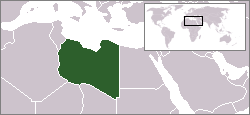 | |
| Capital and largest city | Tripoli |
| Official languages | Arabic |
| Government | People's Congress |
• Leader | Muammar al-Gaddafi (de facto) Zenati Muhammad az-Zenati (de jure) |
| Baghdadi Mahmudi | |
| Independence | |
• Relinquished by Italy | February 10 1947 |
| December 24 1951 | |
• Water (%) | Negl. |
| Population | |
• July 2005 estimate | 5,853,0001 (105th) |
• 2004 census | 5,882,6672 |
| GDP (PPP) | 2005 estimate |
• Total | $67.244 billion (67th) |
• Per capita | $11,630 (58th) |
| HDI (2003) | 0.799 high (58th) |
| Currency | Dinar (LYD) |
| Time zone | UTC+2 (EET) |
• Summer (DST) | UTC+2 (not observed) |
| Calling code | 218 |
| ISO 3166 code | LY |
| Internet TLD | .ly |
Libya (Arabic: ليبيا Lībiyā, Amazigh: ![]() ), officially the Great Socialist People’s Libyan Arab Jamahiriya (الجماهيرية العربية الليبية الشعبية الإشتراكية العظمى), is a country in Northern Africa. Bordering the Mediterranean Sea to the north, Lybia lies between Egypt to the east, Sudan to the southeast, Chad and Niger to the south and Algeria and Tunisia to the west. With an area of 1.8 million square kilometres, 90% of which is desert, Libya is slightly larger in area than Alaska. It is the fourth largest nation in Africa, and the 17th largest in the world.[1] The capital, Tripoli, is home to 1.7 million of Libya's 5.8 million people. The three traditional parts of the country are Tripolitania, the Fezzan, and Cyrenaica.
), officially the Great Socialist People’s Libyan Arab Jamahiriya (الجماهيرية العربية الليبية الشعبية الإشتراكية العظمى), is a country in Northern Africa. Bordering the Mediterranean Sea to the north, Lybia lies between Egypt to the east, Sudan to the southeast, Chad and Niger to the south and Algeria and Tunisia to the west. With an area of 1.8 million square kilometres, 90% of which is desert, Libya is slightly larger in area than Alaska. It is the fourth largest nation in Africa, and the 17th largest in the world.[1] The capital, Tripoli, is home to 1.7 million of Libya's 5.8 million people. The three traditional parts of the country are Tripolitania, the Fezzan, and Cyrenaica.
The name "Libya" is derived from the Egyptian term "Lebu", referring to Berber peoples living west of the Nile, and was adopted into Greek as "Libya". In ancient Greece, the term had a broader meaning, encompassing all of North Africa west of Egypt, and sometimes referring to the entire continent of Africa.
With one of the largest proven oil reserves in the world,[2] Libya has one of the largest per capita GDPs in Africa.[3] Libya is led by revolutionary Col. Muammar al-Gaddafi, whose foreign policy and involvement with terrorist groups have often brought him into conflict with the West.
History
Archaeological evidence indicates that from as early as the eighth millennium BCE, Libya's coastal plain hosted a Neolithic people who were skilled in the domestication of cattle and the cultivation of crops.[4] This culture flourished for thousands of years in the region, millennia before the domination of ancient European forces, until being displaced or absorbed by the Berbers.
The area known in modern times as Libya was later subjected to varying degrees of unifying foreign control, with the Phoenicians, Carthaginians, Greeks, Romans, Vandals, and Byzantines ruling all or part of the area . Although the Greeks and Romans left ruins at Cyrene, Leptis Magna, and Sabratha, little other evidence remains of these ancient cultures.

The Phoenicians were the first to establish trading posts in Libya, when the merchants of Tyre (in present-day Lebanon) developed commercial relations with the Berber tribes and made treaties with them to ensure their cooperation in the exploitation of raw materials.[5][6] By the fifth century BCE, Carthage, the greatest of the Phoenician colonies, had extended its hegemony across much of North Africa, where a distinctive civilization, known as Punic, came into being. Punic settlements on the Libyan coast included Oea (Tripoli), Labdah (later Leptis Magna), and Sabratha, in an area that came to be known collectively as Tripolis, or "Three Cities", from which Libya's modern capital Tripoli takes its name.
The Greeks conquered Eastern Libya when. according to tradition, emigrants from the crowded island of Thera were commanded by the oracle at Delphi to seek a new home in North Africa. In 631 BC, they founded the city of Cyrene.[7] Within 200 years, four more important Greek cities were established in the area: Barce (Al Marj); Euhesperides (later Berenice, present-day Benghazi); Teuchira (later Arsinoe, present-day Tukrah); and Apollonia (Susah), the port of Cyrene. Together with Cyrene, they were known as the Pentapolis (Five Cities).
The Romans unified both regions of Libya, and for more than 400 years, Tripolitania and Cyrenaica became prosperous Roman provinces.[8] Roman ruins, such as those of Leptis Magna, attest to the vitality of the region, where populous cities and even small towns enjoyed the amenities of urban life. Merchants and artisans from many parts of the Roman world established themselves in North Africa, but the character of the cities of Tripolitania remained decidedly Punic and, in Cyrenaica, Greek.
The Arabs conquered Libya in the seventh century CE. In the following centuries, many of the indigenous peoples adopted Islam, and the Arabic language and culture. The Ottoman Turks conquered the country in the mid-16th century, Libya remaining part of their empire, although at times virtually autonomous, until Italy invaded in 1911. In the face of years of resistance, Libya was made a colony.[9]
In 1934, Italy adopted the name "Libya" (used by the Greeks for all of North Africa, except Egypt) as the official name of the colony, which consisted of the provinces of Cyrenaica, Tripolitania, and Fezzan. King Idris I, Emir of Cyrenaica, led Libyan resistance to Italian occupation between the two World Wars. From 1943 to 1951, Tripolitania and Cyrenaica were under British administration, while the French controlled Fezzan. In 1944, Idris returned from exile in Cairo but declined to resume permanent residence in Cyrenaica until the removal of some aspects of foreign control in 1947. Under the terms of the 1947 peace treaty with the Allies, Italy relinquished all claims to Libya.[10]
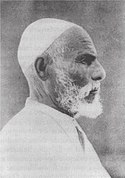
On November 21 1949, the UN General Assembly passed a resolution stating that Libya should become independent before January 1 1952. Idris represented Libya in the subsequent UN negotiations. When Libya declared its independence on December 24 1951, it was the first country to achieve independence through the UN, and one of the first European possessions in Africa to gain independence.[11] Libya was proclaimed a constitutional and hereditary monarchy under King Idris.
The discovery of significant oil reserves in 1959 and the subsequent income from petroleum sales enabled one of the world's poorest nations to establish an extremely wealthy state, as measured by per capita GDP. Although oil drastically improved the Libyan government's finances, popular resentment began to build over the increased concentration of the nation's wealth in the hands of King Idris and the national elite. This discontent continued to mount with the rise of Nasserism and Arab nationalism throughout North Africa and the Middle East.
| History of Libya | ||||||||||||||||||||||||||||||||||||||
|---|---|---|---|---|---|---|---|---|---|---|---|---|---|---|---|---|---|---|---|---|---|---|---|---|---|---|---|---|---|---|---|---|---|---|---|---|---|---|
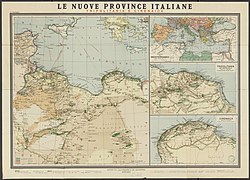 | ||||||||||||||||||||||||||||||||||||||
|
||||||||||||||||||||||||||||||||||||||
|
| ||||||||||||||||||||||||||||||||||||||
On September 1 1969, a small group of military officers led by then 28-year-old army officer Muammar Abu Minyar al-Gaddafi staged a coup d’etat against King Idris. At the time, Idris was in Turkey for medical treatment. His nephew, Crown Prince Sayyid Hasan ar-Rida al-Mahdi as-Sanussi, became King. It was clear that the revolutionary officers who had announced the deposition of King Idris did not want to appoint him over the instruments of state as King. Sayyid quickly found that he had substantially less power as the new King than he had earlier had as a mere Prince. Before the end of September 1, King Sayyid Hasan ar-Rida al-Mahdi as-Sanussi had been formally deposed by the revolutionary army officers and put under house arrest. Meanwhile, revolutionary officers abolished the monarchy, and proclaimed the new Libyan Arab Republic. Gaddafi was, and is to this day, referred to as the "Brother Leader and Guide of the Revolution" in government statements and the official press.[12]
Politics
There is a dual government structure in Libya. The "revolutionary sector" comprises Revolutionary Leader Gaddafi, the Revolutionary Committees and the remaining members of the 12-person Revolutionary Command Council, which was established in 1969.[13] The historical revolutionary leadership is not elected and cannot be voted out of office; they are in power by virtue of their involvement in the revolution. The revolutionary sector dictates the decision-making power of the second sector, the "Jamahiriya Sector".
Constituting the legislative branch of government, this sector comprises Local People's Congresses in each of the 1,500 urban wards, 32 Sha’biyat People's Congresses for the regions, and the National General People's Congress. These legislative bodies are represented by corresponding executive bodies (Local People's Committees, Sha'biyat People's Committees and the National General People’s Committee/Cabinet).
Every four years, the membership of the Local People's Congresses elects by acclamation both their own leadership and secretaries for the People's Committees, sometimes after many debates and a critical vote. The leadership of the Local People's Congress represents the local congress at the People’s Congress of the next level and has an imperative mandate. The members of the National General People's Congress elect the members of the National General People’s Committee (the Cabinet) by acclamation at their annual meeting. The most recent meeting, which took place in Sirte, January 8–January 12 2005, was the 29th annual meeting.[14]
While there is discussion regarding who will run for executive offices, only those approved by the revolutionary leadership are elected. The government administration is effective as long as it operates within the directives of the revolutionary leadership. The revolutionary leadership has absolute veto power despite the constitutionally established people's democracy and alleged rule of the people. The government controls both state-run and semi-autonomous media; articles that are critical of policies have been requested and intentionally published by the revolutionary leadership itself as a means of initiating reforms. In cases involving a violation of "these taboos", the private press, like The Tripoli Post, has been censored.[15]
Political parties were banned by the 1972 Prohibition of Party Politics Act Number 71.[16] According to the Association Act of 1971, the establishment of non-governmental organizations (NGOs) is allowed. However, because they are required to conform to the goals of the revolution, their numbers are small in comparison with those in neighboring countries. Trade unions do not exist,[17] but numerous professional associations are integrated into the state structure as a third pillar, along with the People’s Congresses and Committees. These associations do not have the right to strike. Professional associations send delegates to the General People's Congress, where they have a representative mandate.
Administrative divisions
Initially organized into two to four provinces, Libya has since been divided into several governorates (muhafazat), 25 municipalities (baladiyat)[18] and, most recently, thirty two sha'biyah.[19][20]
 |
Foreign relations
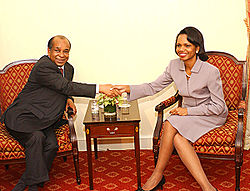
Libya's foreign policies have undergone much fluctuation and change since the state was proclaimed on Christmas Eve, 1951. As a Kingdom, Libya maintained a definitively pro-Western stance, yet was recognized as belonging to the conservative traditionalist bloc in the League of Arab States (Arab League), of which it became a member in 1953.[21] The government was in close alliance with America and Britain; both countries maintained military base rights in Libya. Libya also forged close ties with France, Italy, Greece, and Turkey, and established full diplomatic relations with the Soviet Union in 1955.
Although the government supported Arab causes, including the Moroccan and Algerian independence movements, it took little active part in the Arab-Israeli dispute or the tumultuous inter-Arab politics of the 1950s and early 1960s. The Kingdom was noted for its close association with the West, while it steered an essentially conservative course at home.[22]
After the 1969 coup, Gaddafi closed American and British bases and partially nationalized foreign oil and commercial interests in Libya. He also played a key role in promoting oil embargoes as a political weapon for challenging the West, hoping that an oil price rise and embargo in 1973 would persuade the West, especially the United States, to end support for Israel. Gaddafi rejected both Soviet communism and Western capitalism and claimed he was charting a middle course for his government.[23] In October 1978, Gaddafi was severely criticised for his support of Idi Amin in the Uganda-Tanzania War. Libyan troops sent by Gaddafi aided Idi Amin in trying to annex the northern Tanzanian province of Kagera. Amin lost the battle and later fled to exile in Libya, where he remained for almost a year.[24]
In the 1980s, Libya increasingly distanced itself from the West, and was accused of committing mass acts of state sponsored terrorism. When evidence of Libyan complicity was discovered in the Berlin discotheque terrorist bombing that killed two American servicemen, the United States responded by launching an aerial bombing attack against targets near Tripoli and Benghazi in April 1986.[25]
In 1991, two Libyan intelligence agents were indicted by federal prosecutors in the U.S. and Scotland for their involvement in the December 1988 bombing of Pan Am flight 103. Six other Libyans were put on trial in absentia for the 1989 bombing of UTA Flight 772. The UN Security Council demanded that Libya surrender the suspects, cooperate with the Pan Am 103 and UTA 772 investigations, pay compensation to the victims' families, and cease all support for terrorism. Libya's refusal to comply led to the approval of UNSC Resolution 748 on March 31, 1992, imposing sanctions on the state designed to bring about Libyan compliance. Continued Libyan defiance led to further sanctions by the UN against Libya in November 1993.[26]
In 2003, more than a decade after the sanctions were put in place, Libya began to make dramatic policy changes vis-à-vis the Western world with the open intention of pursuing a Western-Libyan détente. The Libyan government announced its decision to abandon its weapons of mass destruction programs and pay almost 3 billion US dollars in compensation to the families of Pan Am flight 103 as well as UTA Flight 772.[27] The decision was welcomed by many western nations and was seen as an important step for Libya toward rejoining the international community.[28] Since 2003 the country has normalised its ties with the European Union and the United States and has even coined the catchphrase, 'The Libya Model', an example intended to show the world what can be achieved through negotiation rather than force when there is goodwill on both sides.[29]
Geography
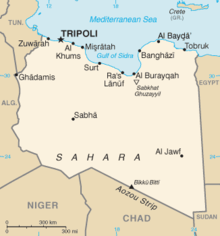

Libya extends over 1,759,540 square kilometres (679,182 sq. mi), making it the 17th largest nation in the world. It is bound to the north by the Mediterranean Sea, the west by Tunisia and Algeria, the southwest by Niger, the south by Chad and Sudan and to the east by Egypt. At 1770 kilometres (1100 miles), Libya's coastline is the longest of any country bordering the Mediterranean.[31][32] The climate is mostly dry and desert-like in nature. However, the northern regions enjoy a milder Mediterranean climate.
The traditional geographic regions are Cyrenaica, Tripolitania, and Fezzan. The chief cities are the capital Tripoli in northwest Libya and Benghazi, located in the east. Other significant cities include Misratah, Sirte and Sabha.[33]
Natural hazards come in the form of hot, dry, dust-laden sirocco (known in Libya as the gibli). This is a southern wind blowing from one to four days in spring and autumn. There are also dust storms and sandstorms. Oases can also be found scattered throughout Libya, the most important of which are Ghadames and Kufra as well as others.
Libyan Desert
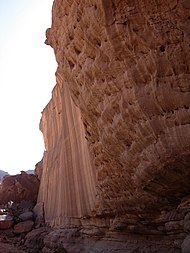
The Libyan Desert, which covers much of eastern Libya, is one of the most arid places on earth. In places, decades may pass without rain, and even in the highlands rainfall happens erratically, once every 5-10 years. At Uweinat, the last recorded rainfall was in September 1998.[34] There is a large depression, the Qattara Depression, just to the south of the northernmost scarp, with Siwa oasis at its western extremity. The depression continues in a shallower form west, to the oases of Jaghbub and Jalo.
Likewise, the temperature in the Libyan desert can be extreme; in 1922, the town of Al 'Aziziyah, which is located west of Tripoli, recorded an air temperature of 57.8°C (136.0°F), generally accepted as the highest recorded naturally occurring air temperature reached on Earth.[35]
There are a few scattered uninhabited small oases, usually linked to the major depressions, where water can be found by digging to a few feet in depth. In the west there is a widely dispersed group of oases in unconnected shallow depressions, the Kufra group, consisting of Tazerbo, Rebiana and Kufra.[34]
Aside from the scarps, the general flatness is only interrupted by a series of plateaus and massifs near the centre of the Libyan Desert, around the convergence of the Egyptian-Sudanese-Libyan Borders.

Slightly further to the south are the massifs of Arkenu, Uweinat and Kissu. These granite mountains are very ancient, having formed much before the sandstones surrounding them. Arkenu and Western Uweinat are ring complexes very similar to those in the Air Mountains. Eastern Uweinat (the highest point in the Libyan Desert) is a raised sandstone plateau adjacent to the granite part further west.[34] The plain to the north of Uweinat is dotted with eroded volcanic features.
In 1996 the movie "The English Patient" raised public interest in the Libyan desert as did the 1992 novel on which the film was based.[36]
Economy
The Libyan economy depends primarily upon revenues from the oil sector, which contribute practically all export earnings and about one-quarter of GDP. These oil revenues and a small population give Libya one of the highest per capita GDPs in Africa and have allowed the Libyan state to provide an extensive and impressive level of social security, particularly in the fields of housing and education.[37] Compared to its market-orientated neighbours, Libya enjoys an extremely low level of both absolute and relative poverty. Libyan officials in the past three years have made progress on economic reforms as part of a broader campaign to reintegrate the country into the international fold.[38] This effort picked up steam after UN sanctions were lifted in September 2003, and as Libya announced in December 2003 that it would abandon programs to build weapons of mass destruction.[39]
Libya has started to respond to international, political and economic pressure to adopt market orientated reforms and has begun liberalizing the socialist-oriented economy.

Initial steps — including applying for WTO membership, reducing some subsidies, and announcing plans for privatization — are laying the groundwork for a transition to a more market-based economy.[40] The non-oil manufacturing and construction sectors, which account for about 20% of GDP, have expanded from processing mostly agricultural products to include the production of petrochemicals, iron, steel, and aluminum. Climatic conditions and poor soils severely limit agricultural output, and Libya imports about 75% of its food.[38]
The Libyan economy is viewed as ripe for modernisation and foreign investment.[41] Under the previous Prime Minister, Shukri Ghanem and current prime minister Baghdadi Mahmudi, it is undergoing a business boom. Many socialist-era government-run industries are being privatized. Most U.S. sanctions have been lifted; as of May 2006, the remaining vestiges are scheduled for removal pending US Congressional approval. Continental Airlines currently offers code-share travel to Libya. Many international oil companies have returned to the country, including controversial oil giants Shell and ExxonMobil.[42] Tourism is on the rise, bringing increased demand for hotel accommodation and for capacity at airports such as Tripoli International. A multi-million dollar renovation of Libyan airports has recently been approved by government to help meet such demands.[43]
Demographics

Libya has a small population within its large territory, with a population density of about 3 persons per square kilometre (8.5/mi²) in the two northern regions of Tripolitania and Cyrenaica, and less than one person per square kilometre (1.6/mi²) elsewhere. Libya is thus one of the least populous nations by area in the world.[44] 90% of the people live in less than 10% of the area, mostly along the coast. More than half the population is urban, concentrated to a greater extent, in the two largest cities, Tripoli and Benghazi.[45] Native Libyans are primarily a mixture of Arabs and Berbers.
There are small Tuareg and Tebu tribal groups concentrated in the south, living nomadic or semi-nomadic lifestyles. Among foreign residents, the largest groups are citizens of other African nations, including North Africans (primarily Egyptians and Tunisians), West Africans and Sub-Saharan Africans.[46] Libyan Berbers and Arabs constitute 97% of the population, the other 3% are Black Africans, Greeks, Maltese, Italians, Egyptians, Pakistanis, Turks, Indians and Tunisians.[47]
The main language spoken in Libya is Arabic, which is also the official language. Tamazight, which do not have official status, are spoken by Libyan Berbers.[48] In addition, Tuaregs speak Tamahaq, the only known Northern Tamasheq language. Italian and English are sometimes spoken in the big cities, although Italian speakers are mainly among the older generation.
Education
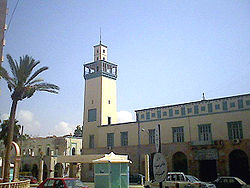
Libya’s population of approximately 5.8 million includes 1.7 million students, over 270,000 of whom study at the tertiary level.[49] Education in Libya is free for all citizens,[50] and compulsory up until secondary level. The literacy rate is the highest in North Africa; 82.6% of the population can read and write.[51] After Libya’s independence in 1951, its first university which formed the foundation of the "University of Libya", was established in Benghazi.[52] In academic year 1975/76 the number of university students was estimated to be 13,418. As of 2004, this number has increased to more than 200,000, with an extra 70,000 enrolled in the higher technical and vocational sector.[49] The rapid increase in the number of students in the higher education sector has been mirrored by an increase in the number of institutions of higher education. Since 1975 the number of universities has grown from two to nine and after their introduction in 1980, the number of higher technical and vocational institutes currently stands at 84.[49] Libya’s higher education is financed by the public budget. In 1998, the budget allocated for education represented 38.2% of the national budget.[52]
Religion

By far the predominant religion in Libya is Islam with 97% of the population associating with the faith.[53] Nearly all Libyan Muslims adhere to Sunni Islam, which provides both a spiritual guide for individuals and a keystone for government policy.
Before the 1930s, the Sanusi Movement was the primary Islamic movement in Libya. This was a religious revival adapted to desert life. Its zawaayaa (lodges) were found in Tripolitania and Fezzan, but Sanusi influence was strongest in Cyrenaica. Rescuing the region from unrest and anarchy, the Sanusi movement gave the Cyrenaican tribal people a religious attachment and feelings of unity and purpose.[54] This Islamic movement, which was eventually destroyed by both Italian invasion and later the Gaddafi government,[54] was very conservative and somewhat different from the Islam that exists in Libya today. Gaddafi asserts that he is a devout Muslim, and his government is taking a role in supporting Islamic institutions and in worldwide proselytizing on behalf of Islam.[55] Libyan Islam, however, has always been considered traditional, but in no way harsh compared to Islam in other countries. A Libyan form of Sufism is also common in parts of the country.[56]
Other than the overwhelming majority Sunni Muslims, there are also very small Christian communities, composed almost exclusively of foreigners. There is a small Anglican community, made up mostly of African immigrant workers in Tripoli; it is part of the Egyptian Diocese.[57] There are also an estimated 40,000 Roman Catholics in Libya who are served by two Bishops, one in Tripoli (serving the Italian community) and one in Benghazi (serving the Maltese community).
Libya was until recent times the home of one of the oldest Jewish communities in the world, dating back to at least 300 BCE.[58] A series of pogroms beginning in November of 1945 lasted for almost three years, drastically reducing Libya's Jewish population.[59] In 1948, about 38,000 Jews remained in the country.
Upon Libya's independence in 1951, most of the Jewish community emigrated from Libya. Another series of pogroms began after the Suez Crisis in 1956, forcing all but about 100 Jews to flee. When Gaddafi came to power, all remaining Jewish property was confiscated and all debts to Jews were cancelled. Gaddafi has recently announced, however, that suitable compensation would be given to Libyan Jews who were displaced.[60] Although the main synagogue in Tripoli was renovated in 1999, it has yet to re-open for services.
Culture
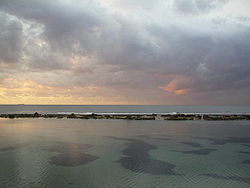
Libya is culturally similar to its neighbouring Arab states. While the primary language of the country is a local colloquial form of Arabic,[61] the Libyan people consider themselves very much a part of a wider Arab community. There seem to be two distinct dialects and a small number of village and tribal dialects. Libyan Arabs have a heritage in the traditions of the nomadic Bedouin and associate themselves with a particular Bedouin tribe.
Family life is important for Libyan families, the majority of which live in apartment blocks and other independent housing units, with precise modes of housing depending on their income and wealth. Although the Libyan Arabs traditionally lived nomadic lifestyles in tents, they have now settled in various towns and cities.[62] Because of this, their old ways of life are gradually fading out. An unknown small number of Libyans still live in the desert as their families have done for centuries. Most of the population has occupations in industry and services, and a small percentage is in agriculture.
As with some other countries in the Arab world, Libya boasts few theatres or art galleries. Public entertainment is almost nonexistent, even in the big cities.[63] Recently there has been a revival of the arts in Libya, especially painting; private galleries are springing up to provide a showcase for new talent.[64] Conversely, for many years there have been no public theatres, and only a few cinemas showing foreign films. The tradition of folk culture is still alive and well, with troupes performing music and dance at frequent festivals, both in Libya and abroad. The main output of Libyan television is devoted to showing various styles of traditional Libyan music. Tuareg music and dance are popular in Ghadames and the south. Libyan television programmes are mostly in Arabic with a 30-minute news broadcast each evening in English and French. The government maintains strict control over all media outlets; A new analysis by the Committee to Protect Journalists has found Libya’s media the most tightly controlled in the Arab world.[15] To combat this, the government plans to introduce private media, an initiative intended to bring the country's media in from the cold.[65]
Many Libyans frequent the country's beaches. They also visit Libya's beautifully-preserved archaeological sites—especially Leptis Magna, which is widely considered to be one of the best preserved Roman archaeological sites in the world.[66]
The nation's capital, Tripoli, boasts many good museums and archives; these include the Government Library, the Ethnographic Museum, the Archaeological Museum, the National Archives, the Epigraphy Museum and the Islamic Museum. The Jamahiriya Museum, built in consultation with UNESCO, may be the country's most famous; it houses one of the finest collections of classical art in the Mediterranean.[67]
See also
| Topics in Libya | |
|---|---|
| History | Italo-Turkish War |
| Geography | Municipalities | Cities | Mediterranean Sea |
| Politics | Prime Minister | General People's Congress | Heads of Government |
| Economy | Transport | Communications | Demographics | Companies | Great Manmade River |
| Culture | Indigenous religion | Languages: Arabic, Tamahaq, Italian | Sport | Music | Scouts and Girl Guides |
| Other | Libyan Jewish population | Libyan Football team |
International rankings
| Organisation | Survey | Ranking |
|---|---|---|
| Heritage Foundation/The Wall Street Journal | 2006 Index of Economic Freedom | 152 out of 157 |
| The Economist | The World in 2005 - Worldwide quality-of-life index, 2005 | 70 out of 111 |
| Energy Information Administration | Greatest Oil Reserves by Country, 2006 | 9 out of 20 |
| Reporters Without Borders | Press Freedom Index (2005) | 162 out of 167 |
| Transparency International | Corruption Perceptions Index 2005 | 117 out of 158 |
| United Nations Development Programme | Human Development Index 2005 | 58 out of 177 |
References
- ^ U.N. Demographic Yearbook, (2003), "Demographic Yearbook (3) Pop., Rate of Pop. Increase, Surface Area & Density", United Nations Statistics Division, Accessed July 15 2006
- ^ Annual Statistical Bulletin, (2004), "World proven crude oil reserves by country, 1980–2004", O.P.E.C., Accessed July 20 2006
- ^ World Economic Outlook Database, (April, 2006), "Report for Selected Countries and Subjects", International Monetary Fund, Accessed July 15 2006
- ^ Federal Research Division of the Library of Congress, (1987), "Early History of Libya", U.S. Library of Congress, Accessed July 11 2006
- ^ Herodotus, (c.430 BCE), "'The Histories', Book IV.42–43" Fordham University, New York, Accessed July 18 2006
- ^ Federal Research Division of the Library of Congress, (1987), "Tripolitania and the Phoenicians", U.S. Library of Congress, Accessed July 11 2006
- ^ Federal Research Division of the Library of Congress, (1987), "Cyrenaica and the Greeks", U.S. Library of Congress, Accessed July 11 2006
- ^ Heuser, Stephen, (July 24, 2005), "When Romans lived in Libya", The Boston Globe Accessed July 18 2006
- ^ Country Profiles, (May 16, 2006), "Timeline: Libya, a chronology of key events" BBC News, Accessed July 18 2006
- ^ Hagos, Tecola W., (November 20, 2004), "Treaty Of Peace With Italy (1947), Evaluation And Conclusion", Ethiopia Tecola Hagos, Accessed July 18 2006
- ^ "December 24, 1951: Libya declares its independence under King Idris", Global Connections - The Middle East, Accessed July 15 2006
- ^ US Department of State's Background Notes, (Nov, 2005) "Libya - History", U.S. Dept. of State, Accessed July 14 2006
- ^ Federal Research Division of the Library of Congress, (1987), "Government and Politics of Libya", U.S. Library of Congress, Accessed July 14 2006
- ^ Middle East and N. Africa, Amnesty International, Public Statement, (Jan 13, 2005), "Libya: Abolition of People's Court is an important step", Amnesty International USA, Accessed July 17 2006
- ^ a b Special Report 2006, (May 2, 2006), "North Korea Tops CPJ list of '10 Most Censored Countries'", Committee to Protect Journalists, Accessed July 19 2006
- ^ Case Study: Libya, (2001), "Political Culture", Educational Module on Chemical & Biological Weapons Nonproliferation, Accessed July 14 2006
- ^ Hodder, Kathryn, (2000), "Violations of Trade Union Rights", Social Watch Africa, Accessed July 14 2006
- ^ Lahmeyer, Jan, (November 26, 2004), "Historical demographical data of the administrative division", Universiteit Utrecht, Accessed July 19 2006
- ^ Jamahiriya News Agency, (July 19, 2004), "Masses of the Basic People's Congresses select their Secretariats and People's Committees" Mathaba News, Accessed July 19 2006
- ^ Template:Ar icon "Municipalities of Libya", Website of the General People's Committee of Libya Accessed July 19, 2006
- ^ Federal Research Division of the Library of Congress, (1987), "Independant Libya", U.S. Library of Congress, Accessed July 14 2006
- ^ Abadi, Jacob (2000), "Pragmatism and Rhetoric in Libya's Policy Toward Israel", The Journal of Conflict Studies: Volume XX Number 1 Fall 2000, University of New Brunswick, Accessed July 19 2006
- ^ The Columbia Encyclopedia, Sixth Edition, (2001 - 2005), "Qaddafi, Muammar al-", Bartleby Books, Accessed July 19 2006
- ^ Biography, "Idi Amin", Cape Breton-Victoria Regional School Board, Accessed July 19 2006
- ^ Boyne, Walter J., (March, 1999), "El Dorado Canyon", Air Force Association Journal, Vol. 82, No. 3, Accessed July 19 2006
- ^ (2003), "Libya", Global Policy Forum, Accessed July 19 2006
- ^ Marcus, Jonathan, (May 15, 2006), "Washington's Libyan fairy tale", BBC News, Accessed July 15 2006
- ^ U.K. Politics, (March 25, 2004), "Blair hails new Libyan relations", BBC news, Accessed July 15 2006
- ^ Hirsh, Michael, (May 11, 2006), "The Real Libya Model", Newsweek, Accessed July 15 2006
- ^ Federal Research Division of the Library of Congress, (1987), "Climate & Hydrology of Libya", U.S. Library of Congress, Accessed July 15 2006
- ^ (2005), "Demographics of Libya", Education Libya, Accessed June 29 2006
- ^ (July 20, 2006), "Field Listings - Coastlines", CIA World Factbook, Accessed July 23 2006
- ^ The national authority for information and authentication, Libya, (2004), "Census of Libya, 2004", Libyan Jamahiriya Broadcasting Corporation, Accessed July 17 2006
- ^ a b c Zboray, András, "Flora and Fauna of the Libyan Desert", Fliegel Jezerniczky Expeditions, Accessed July 14 2006
- ^ Hottest Place, "El Azizia Libya, 'How Hot is Hot?'", Extreme Science, Accessed July 14 2006
- ^ Fledderus, Bill, (1997), "The English Patient Reposed in His Bed Like a (Fisher?) King", Elements of Grail Romance in Ondaatje's The English Patient, University of New Brunswick Libraries, Accessed July 19 2006
- ^ United Nations Economic & Social Council, (Feb 16, 1996), "Libyan Arab Jamahiriya Report", Office of the United Nations High Commissioner for Human Rights, Accessed July 14 2006
- ^ a b The World Factbook, (2006), "Economy - Libya", CIA World Factbook, Accessed July 14 2006
- ^ W.M.D., (2003), "Libya Special Weapons News", Global Security Report, Accessed July 14 2006
- ^ Reuters, (July 28, 2004), "Libya to start WTO membership talks", Trade Law Centre for Southern Africa, Accessed July 16 2006
- ^ (2003), "Libyan Trade Links with the UK", U.K. Trade and Investment, Accessed July 14 2006
- ^ Volume: 23, No. 27, (2006), "Shell returns to Libya with gas exploration pact", Oil & Gas Worldwide News, Accessed July 14 2006
- ^ Jawad, Rana, (May 31, 2006), "Libyan aviation ready for take-off" BBC News, Accessed July 22 2006
- ^ Earth Trends, Environmental Information, (2004), "Population: Population density", World Resources Institute, Accessed July 19 2006
- ^ Al-Amari, Mailud, (Nov, 2004), "Population Dynamics and Fertility Trends in Libya", American Public Health Association, Accessed July 17 2006
- ^ Libya Demographics and Geograhy, (2005), "Libya - Population" The Columbia Gazetteer of the World, Accessed July 17 2006
- ^ The World Factbook, (2006), "People - Libya", CIA World Factbook, Accessed July 19 2006
- ^ Anderson, Lisa, (2006), "'Libya', III. People, B. Religion & Language", MSN Encarta, Accessed July 17 2006
- ^ a b c Clark, Nick, (July, 2004), "Education in Libya", World Education News and Reviews, Volume 17, Issue 4, Accessed July 22 2006
- ^ Federal Research Division of the Library of Congress, (1987), "Education of Libya", U.S. Library of Congress, Accessed July 22 2006
- ^ (July, 2006) "Field Listing - Literacy", CIA World Factobook, Accessed July 22 2006
- ^ a b El-Hawat, Ali, (2000), "Country Higher Education Profiles - Libya", International Network for Higher Education in Africa", Accessed July 22 2006
- ^ Religious adherents by location, "'42,000 religious geography and religion statistics', Libya" Adherents.com, Accessed July 15, 2006
- ^ a b Federal Research Division of the Library of Congress, (1989), "The Sanusis", U.S. Library of Congress, Accessed July 22, 2006
- ^ Federal Research Division of the Library of Congress, (1989), "Islam in Revolutionary Libya", US Library of Congress, Accessed July 19 2006
- ^ Libya - Religion, (July 8, 2006), "Sufi Movement to be involved in Libya" Arabic News, Accessed July 19 2006
- ^ (2004), "International Religious Freedom Report: Libya" Jewish Virtual Library, Accessed July 19 2006
- ^ The World Jewish Congress, "History of the Jewish Community in Libya", University of California at Berkeley, Accessed July 16 2006
- ^ Harris, David A. (2001), "In the Trenches: Selected Speeches and Writings of an American Jewish Activist", 1979-1999, pp. 149-150
- ^ World News, (September 1, 2004), "Gaddafi to compensate Libyan Jews for lost homes", New Zealand Herald, Accessed July 20 2006
- ^ Gordon, Raymond G., Jr. (ed.), (2005), "Arabic Libyan", Ethnologue: Languages of the World, Fifteenth edition, Accessed July 17, 2006
- ^ Al-Hawaat, Dr. Ali, (1994), "The Family and the work of women, A study in the Libyan Society" National Center for Research and Scientific Studiesof Libya, Accessed July 19, 2006
- ^ News and Trends: Africa, (September 17, 1999), "Libya looking at economic diversification" Alexander's Gas & Oil Connections, Accessed July 19 2006.
- ^ About Libya, "Libya Today", Discover Libya Travel, Accessed July 14 2006.
- ^ (Jan 30, 2006), "Libya to allow independent media", Middle East Times, Accessed July 21 2006
- ^ Donkin, Mike, (July 23, 2005), "Libya's tourist treasures", BBC News, Accessed July 19 2006
- ^ Bouchenaki, Mounir, (1989), "The Libyan Arab Jamahiriya Museum: a first in the Arab world", UNESCO, Museum Architecture: beyond the <<temple>> and ... beyond, Accessed July 19, 2006
- Libya, Anthony Ham, Lonely Planet Publications, 2002, ISBN 0864426992
- Libya Handbook, Jamez Azema, Footprint Handbooks, 2001, ISBN 1900949776
- Harris, David A. (2001). In the Trenches: Selected Speeches and Writings of an American Jewish Activist, 1979-1999. KTAV Publishing House, Inc. ISBN 0881256935
- Wright, John L. Nations of the Modern World: Libya, Ernest Benn Ltd, 1969
- Template:CIAfb
 This article incorporates public domain material from U.S. Bilateral Relations Fact Sheets. United States Department of State.
This article incorporates public domain material from U.S. Bilateral Relations Fact Sheets. United States Department of State.
External links
- General People's Committee (The Cabinet)
- The People's Committee of Foreign Affairs
- Libyan Liaison Office, Washington D.C.
- Libyan People's Bureau (Libyan Embassy), Ottawa
- Libyan Cultural Affairs, London.
- Libyan American Chamber of Commerce
- Template:Wikitravel
- Libyan Arab Airlines
- Libya Connected
- Libya Tourism Forums



